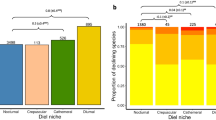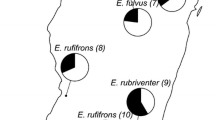Abstract
Deer species included in the genus Mazama descend from two different clades that experienced a strong evolutionary convergence in morphology and behaviour when they adapted to Neotropical forests. We would expect that circadian activity rhythms also converged according to habitat features or responded to temporal niche segregation in sympatric species. We used camera trapping in four study areas, representing three main biomes in Brazil, together with data taken from the literature, to analyse activity patterns of five Mazama species in four biomes in South America. Our results show that clade assignment was the main predictor of diurnal versus nocturnal activity, thus suggesting a phylogenetic constraint rather than any other ecological influence on circadian activity. We discuss how the evolutionary history of both lineages may have influenced their activity patterns.
Similar content being viewed by others
References
Abril, V.V., Vogliotti, A., Varela, D.M., Duarte, J.M.B., Cartes, J.L, 2010. Brazilian dwarf brocket deer Mazama nana (Hensel 1872). In: Duarte, J.M.B., González, S. (Eds.), Neotropical Cervidoloy: Biology and Medicine of Latin American Deer. FUNEP/IUCN, Jaboticabal, pp. 160–165.
Andersen, R., Gaillard, J.M., Liberg, O., San José, C, 1998. Variation in life-history parameters in roe deer. In: Andersen, R., Duncan, P., Linnell, J.D.C. (Eds.), The European Roe Deer: The Biology of Success. Scandinavian University Press, Oslo, pp. 285–307.
Ayres, M., Ayres Jr., M., Ayres, D.L., Santos, A.A., 2007. BIOESTAT: Aplicacões estatísticas nas áreas das ciências bio-médicas, Version 5.3. Instituto Mamirauá, Belém.
Beier, P., Mccullough, D.R., 1990. Factors Influencing white-tailed-deer activity patterns and habitat use, Wildl. Monogr. 109, 1–51.
Black-Décima, P., Rossi, R.V., Vogliotti, A., Cartes, J.L, Maffei, L, Duarte, J.M.B., González, S., Juliá, J.P., 2010. Brown brocket deer Mazama gouazoubira (Fischer 1814). In: Duarte, J.M.B., González, S. (Eds.), Neotropical Cervidoloy: Biology and Medicine of Latin American Deer. FUNEP/IUCN, Jaboticabal, pp. 190–201.
Black-Décima, P., 2000. Home range social structure, and scent marking behaviour in brown brocket deer (Mazama gouazoubira) in a large enclosure, Mastozool. Neotrop. 7, 5–14.
Boczko, R., 1988. Conceitos de Astronomi, Edgard Blücker, São Paulo. De Vivo, M., Carmignotto, P., 2004. Holocene vegetation change and the mammal faunas of South America and Africa. J. Biogeogr. 31, 943–957.
Di-Bitetti, M.S., Paviolo, A., Ferrari, C.A., De Angelo, C, Di Blanco, Y., 2008. Differential responses to hunting in two sympatric species of brocket deer (Mazama americana and M, nana). Biotropica 40, 636–645.
Duarte, J.M.B., González, S., Maldonado, J.E., 2008. The surprising evolutionary history of South American deer, Mol. Phylogenet. Evol. 49, 17–22.
Duarte, J.M.B., González, S., 2010. Neotropical cervidology: biology and medicine of Latin American deer. Jaboticabal.
Foster, S.A., Sih, A., 2013. Behavioural plasticity and evolution. Anim. Behav. 85, 1003.
Fox, R.J., Bellwood, D.R., 2011. Unconstrained by the clock? Plasticity of diel activity rhythm in a tropical reef fish, Siganuslineatus lineatus, Funct. Ecol. 25, 1096–1105.
Gallina, S., Mandujano, S., Bello, J., Arévalo, F.L., Weber, M., 2010. White-tailed deer Odocoileus virginianus (Zimmermann 1780). In: Duarte, J.M.B., González, S. (Eds.), Neotropical Cervidoloy: Biology and Medicine of Latin American Deer. FUNEP/IUCN, Jaboticabal, pp. 101–118.
Geist, V., 1998. Deer of the World: Their Evolution, Behaviour, and Ecology. Stackpole Books, Mechanicsburg.
Gómez, H., Wallace, R.B., Ayala, G., Tejada, R., 2005. Dry season activity periods of some Amazonian mammals, Stud. Neotrop. Fauna Environ. 40, 91–95.
González, S., Cosse, M., Braga, F.G., Vila, A.R., Merino, M.L., Dellafiore, C, Cartes, J.L., Maffei, L, Dixon, M.G., 2010. Pampas deer Ozotoceros bezoarticus (Linnaeus 1758). In: Duarte, J.M.B., González, S. (Eds.), Neotropical Cervidoloy: Biology and Medicine of Latin American Deer. FUNEP/IUCN, Jaboticabal, pp. 119–132.
Haffer, J., 1969. Speciation on Amazonian forest birds, Science 165, 131–137.
Hardin, G., 1960. The competitive exclusion principle, Science 131, 1292–1297.
Jacobs, G.H., 1993. The distribution and nature of colour vision among the mammals, Biol. Rev. 68, 413–471.
Jarman, P.J., 1974. The social organisation of antelope in relation to their ecology, Behaviour 48, 215–267.
Kammermeyer, K.E., Marchinton, R.L., 1977. Seasonal change in circadian activity of radio-monitored deer, J. Wildl. Manage. 41, 315–317.
Kronfeld-Schor, N., Dayan, T., Elvert, R., Haim, A., Zisapel, N., Heldmaier, G., 2001. On the Use of the time axis for ecological separation: diel rhythms as an evolutionary constraint, Am. Nat. 158, 451–457.
Kronfeld-Schor, N., Dayan, T., 2003. Partitioning of time as an ecological resource, Annu. Rev. Ecol. Evol. Syst. 34, 153–181.
Kronfeld-Schor, N., Dayan, T., 2008. Activity patterns of rodents: the physiological ecology of biological rhythms, Biol. Rhythm Res. 39, 193–211.
Losos, J.B., 2008. Phylogenetic niche conservatism: phylogenetic signal and the relationship between phylogenetic relatedness and ecological similarity among species, Ecol. Lett. 11, 995–1007.
Maffei, L., Cuéllar, E., Noss, A.J., 2002. Using camera-traps to assess mammals in the chaco-chiquitano ecotone, Rev. Boliv. Ecol. Conserv. 11, 55–65.
Merino, M.L., Rossi, R.V., 2010. Origin, systematics, and morphological radiation. In: Duarte, J.M.B., González, S. (Eds.), Neotropical Cervidoloy: Biology and Medicine of Latin American Deer. FUNEP/IUCN, Jaboticabal, pp. 2–11.
Monterosso, P., Alves, P.C., Ferreras, P., 2014. Plasticity in circadian activity patterns of mesocarnivores in Southwestern Europe: implications for species coexistence, Behav. Ecol. Sociobiol. 68, 1403–1417.
Nowak, R.M., 1999. Walker’s mammals of the world, 6th ed. Johns Hopkins University Press, Baltimore.
Oliveira-Santos, L.G.R., Zucco, C.A., Agostinelli, C, 2013. Using conditional circular kernel density functions to test hypotheses on animal circadian activity, Anim. Behav. 85, 269–280.
Owen-Smith, N., Goodall, V., 2014. Coping with savanna seasonality: comparative daily activity patterns of African ungulates as revealed by GPS telemetry, J. Zool. 293, 181–191.
Pérez-Barbería, F.J., Gordon, I.J., Pagel, M., 2002. The origins of sexual dimorphism in body size in ungulates, Evolution 56, 1276–1285.
Piersma, T., Drent, J., 2003. Phenotypic flexibility and the evolution of organismal design, Trends Ecol. Evol. 18, 228–233.
Piovezan, U., Tiepolo, L.M., Tomas, W.M., Duarte, J.M.B., Varela, D., Marinho-Filho, J.S., 2010. Marsh deer Blastocerus dichotomus (Illiger 1815). In: Duarte, J.M.B., González, S. (Eds.), Neotropical Cervidoloy: Biology and Medicine of Latin American Deer. FUNEP/IUCN, Jaboticabal, pp. 66–76.
Ridout, M.S., Linkie, M., 2009. Estimating overlap of daily activity patterns from camera trap data, J. Agric. Biol. Environ. Stat. 14, 322–337.
Rivero, K., Rumiz, D.I., Taber, A.B., 2004. Estimating brocket deer (Mazama gouazoubira and M. americana) abundance by dung pellet counts and other indices in seasonal Chiquitano forest habitats of Santa Cruz, Bolivia. Eur. J. Wildl. Res. 50, 161–167, https://doi.org/10.1007/s10344-004-0064-x
Rivero, K., Rumiz, D.I., Taber, A.B., 2005. Differential habitat use by two sympatric brocket deer species (Mazama americana and M, gouazoubira) in a seasonal Chiquitano forest of Bolivia. Mammalia 69, 169–183.
Roll, U., Dayan, Y., Kronfeld-Schor, N., 2006. On the role of phylogeny in determining activity patterns of rodents, Evol. Ecol. 20, 479–490.
Rossi, R.V., Bodmer, R., Duarte, J.M.B., Trovati, R.G., 2010. Amazonian brown brocket deer—Mazama nemorivaga (Cuvier 1817). In: Duarte, J.M.B., González, S. (Eds.), Neotropical Cervidoloy: Biology and Medicine of Latin American Deer. FUNEP/IUCN, Jaboticabal, pp. 202–210.
Tobler, M.W., Carrillo-Percastegui, S.E., Powell, G., 2009. Habitat use, activity patterns and use of mineral licks by five species of ungulate in south-eastern Peru, J. Trop. Ecol. 25, 261–270.
Van Schaik, C.P., Griffiths, M., 1996. Activity periods of Indonesian rain forest mammals, Biotropica 28, 105–112.
Varela, D.M., Trovati, R.G., Guzmán, K.R., Rossi, R.V., Duarte, J.M.B., 2010. Red brocket deer—Mazama americana. In: Duarte, J.M.B., González, S. (Eds.), Neotropical Cervidoloy: Biology and Medicine of Latin American Deer. FUNEP/IUCN, Jaboticabal, pp. 151–159.
Vila, A.R., Galvez, C.E.S., Aldridge, D., Ramilo, E., González, P.C., 2010. South Andean huemul Hippocamelus bisulcus (Molina 1782). In: Duarte, J.M.B., González, S. (Eds.), Neotropical Cervidoloy: Biology and Medicine of Latin American Deer. FUNEP/IUCN, Jaboticabal, pp. 89–100.
Vogliotti, A., Duarte, J.M.B., 2010. Small red brocket deer—Mazama bororo. In: Duarte, J.M.B., González, S. (Eds.), Neotropical Cervidoloy: Biology and Medicine of Latin American Deer. FUNEP/IUCN, Jaboticabal, pp. 218–227.
Webb, S.L., Gee, K.L., Strickland, B.K., Demarais, S., DeYoung, R.W., 2010. Measuring fine-scale white-tailed deer movements and environmental influences using GPS collars, Int. J. Ecol. 2010, 1–12, https://doi.org/10.1155/2010/459610
Weber, M., González, S., 2003. Latin American deer diversity and conservation: a review of status and distribution, Ecoscience 10, 443–454.
Wiens, J.J., 2004. Speciation and ecology revisted: phylogenetic niche conservatism and the origin of species, Evolution (N. Y) 58, 193–197, https://doi.org/10.1111/j.0014-3820.2004.tb01586.x
Author information
Authors and Affiliations
Corresponding author
Rights and permissions
About this article
Cite this article
de Oliveira, M.L., de Faria Peres, P.H., Vogliotti, A. et al. Phylogenetic signal in the circadian rhythm of morphologically convergent species of Neotropical deer. Mamm Biol 81, 281–289 (2016). https://doi.org/10.1016/j.mambio.2016.01.004
Received:
Accepted:
Published:
Issue Date:
DOI: https://doi.org/10.1016/j.mambio.2016.01.004




